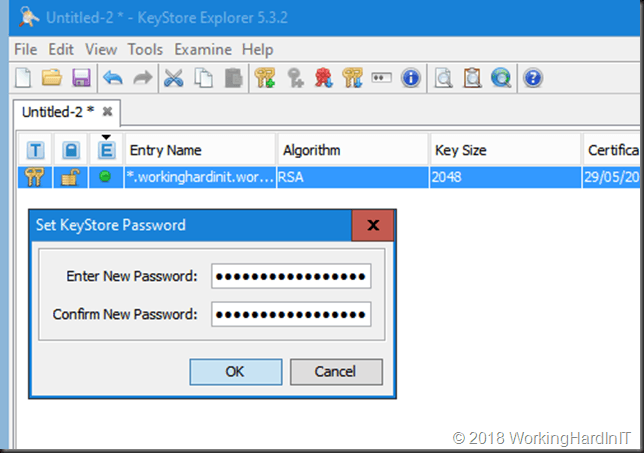
You can verify the contents of the key store using the Java keytool utility with the following command: keytool -v -list -keystore mykeystore.p12 -storetype pkcs12įinally if you need to you can convert this to a JKS key store by importing the key store created above into a new key store: keytool -importkeystore -srckeystore mykeystore.p12 -destkeystore clientcert. NOTE that the name provided in the second command is the alias of your key in the new key store. Openssl pkcs12 -export -in mypemfile.pem -out mykeystore.p12 -name "M圜ert" The following two commands convert the pfx file to a format that can be opened as a Java PKCS12 key store: openssl pkcs12 -in mypfxfile.pfx -out mypemfile.pem
#Keystore explorer export pfx mac os
Many operating systems already have it installed as I found with Mac OS X. Click Submit pfx The name of the -pfx file. This answer on JGuru is the best method that I've found so far.įirstly make sure that you have OpenSSL installed. Step 3 (Optional) Scenario: I have a key file ( This post was most recently updated on April 9th, 2020 pfx, except that the shell line which created bob keytool -genkey -alias hive -keyalg RSA -keystore keystore keytool -genkey -alias hive -keyalg RSA -keystore keystore. destkeystore clientcert.jks -deststoretype JKS Now you can import the file to the destination machine and configure the web server to use it.It has been pointed out by Justin in the comments below that keytool alone is capable of doing this using the following command (although only in JDK 1.6 and later): keytool -importkeystore -srckeystore mypfxfile.pfx -srcstoretype pkcs12 Note: Please replace the “qqq” behind “-srcalias” with the alias, you noted in the previous step and the “xxx” behind “-deststorepass” with the password for the .jks file. The last step is now to import the certificate and its private key into the keystore by running the following command: keytool -importkeystore -srckeystore d:\cert\wildcard.pfx -srcstoretype pkcs12 -srcalias -destkeystore d:\cert\wildcard.jks -deststoretype jks -deststorepass xxx -destalias wildcard Open the file cert.txt and look for the line starting with “ Aliasname:“. To do so, run the following command: keytool -v -list -storetype pkcs12 -keystore d:\cert\wildcard.pfx > d:\cert\cert.txt In order to import the certificate, we first have to reveal the alias used. Now we import the other two CA certificates the same way: keytool -import -trustcacerts -file "d:\cert\COMODORSAAddTrustCA.crt" -alias COMODORSAAddTrustCA -keystore d:\cert\wildcard.jks -storepass xxx keytool -import -trustcacerts -file "d:\cert\COMODORSAOrganizationValidationSecureServerCA.crt" -alias COMODORSAOrganizationValidationSecureServerCA -keystore d:\cert\wildcard.jks -storepass xxx Note: Please replace the “xxx” behind “-storepass” with a reasonable password. Since the key store doesn’t exist, it will create it automatically: keytool -import -trustcacerts -file "d:\cert\AddTrustExternalCARoot.crt" -alias AddTrustExternalCARoot -keystore d:\cert\wildcard.jks -storepass xxx The first command puts the root CA’s certificate into the keystore. Now, we’ll use the keytool command inside the java installation folder (in my case C:\Program Files\Java\jre1.8.0_201\bin to create the keystore and put all necessary files in there. COMODORSAOrganizationValidationSecureServerCA.crt.In my case the folder contained the following files:



Create a folder to collect all necessary files in.So, in order to fulfill this request, the following steps were necessary:
#Keystore explorer export pfx windows 10
Since I use a Windows 10 workstation, I had to assure, that Java was installed, in my case version 1.8. It didn’t contain the certificates of the intermediate CAs.The certificate to be used had two “issues”: Recently I got the request to manually create a Java keystore (.jks) to be used on a linux-based webserver.


 0 kommentar(er)
0 kommentar(er)
